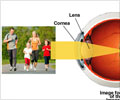- Myopia or nearsightedness is an eye disorder, which affects more than one billion people worldwide.
- A newly discovered cell in the retina called ‘ON Delayed’ is over stimulated by indoor light spectrum, causing myopia.
- This discovery could pave the way for developing new treatments for myopia.
The cell discovered in the retina is highly sensitive to light and controls how the eye grows and develops. The eyes need to stop growing at the right time during childhood. But, if the newly discovered cell instructs the eye to grow long, the images fail to be focused on the retina, which causes nearsighted vision and the individual may require corrective glasses or contact lenses for a lifetime.
There are about 50 types of retinal ganglion cells, which convey all the information to perceive the visual world. Each cell provides different visual information such as color or motion.
The retina contains a signal to focus the image in the eye. The signal plays a key role in regulating eye growth during childhood.
"But for years no one knew what cell carried the signal. We potentially found the key missing link, which is the cell that actually does that task and the neural circuit that enables this important visual function," said Schwartz.
Too Much Time Indoors may Trigger Myopia
The ON Delayed retinal ganglion cell is overstimulated by such patterns, which cause aberrant overgrowth of the eye, leading to myopia.
The study published in the Current Biology was conducted by Schwartz and co-author Adam Mani, a postdoctoral fellow in ophthalmology at Feinberg.
Microscopic glass electrodes were used to record the electrical signals from cells in a mouse retina, while presenting patterns of light on a digital projector.
The research team hopes to find a gene specific to the On Delayed cell. In future studies, the cells activity can be turned up or down in a genetic mouse model to try to induce or treat myopia.
The current research is a part of another larger body of research that aims to reverse engineer the retina by identifying new retinal cell types in mice.
The research was funded by the National Institutes of Health (NIH). Schwartz wants to identify the new cells by their specific function, genetic signatures and understand how the cells are interconnected within the retina and the targets in the brain.
This discovery could lead to gene therapy to treat blindness and improve the function of artificial retinal prosthetics.
Myopia
Myopia is a common type of refractive error where close objects appear clearly whereas distant objects appear blurry. It is a refractive error in which the eye does nor refract light properly to a single focus to see images clearly.
Globally, more than one billion people have myopia. The incidence of myopia is rising and is linked to the time duration people spend indoors as children. Myopia is identified in children between the ages 8 and 12 years old. Myopia worsens during the teenage years.
Reference:
- Adam Mani, Gregory W. Schwartz. Circuit Mechanisms of a Retinal Ganglion Cell with Stimulus-Dependent Response Latency and Activation Beyond Its Dendrites. Current Biology (2017) DOI: http://dx.doi.org/10.1016/j.cub.2016.12.033
- Nearsightedness: What Is Myopia? - (https://www.aao.org/eye- health/diseases/myopia-nearsightedness)
Source-Medindia










